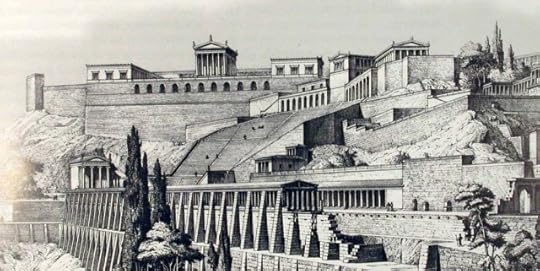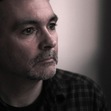Mark David's Blog, page 2
August 7, 2017
Awakening
To receive news of the forthcoming release of Awakening, signup for The Elements newsletter
I started self-publishing in January this year 2017
…and somehow along the line, I just became very disheartened with the entire self-publishing game. My books weren’t selling. Why? No reviews, no visibility. I can count my sales on more than two hands, but the sales have been literally, depressingly few. I launched the first book in The Elements series proper. After two weeks, not one sale.
I probably do everything wrong, and I admit, I’m no marketeer. But neither do I adhere to the sort of tactics used by many indies’ – independent publishers – tactics I hold in disdain. I wont play stupid games and I’ll stick to writing quality fiction, even if it does tale a long time to get the job done right.
What happened today was completely unexpected. And really quite wonderful.
 Interstellar
InterstellarInspiration from Interstellar
Over the summer, I’ve been listening a lot to the sound track to Interstellar. It is a work of genius by Hans Zimmer, a composer many know well from many great films. I listened to this to send me to sleep, not because it was boring, but because it so soothing, inspiring and other-worldly, which was the whole point behind it all.
This set off the creativity engine – I’m a very creative person.
Now, my books are planned around theme, universe, setting and involves a lot of mystery building. This time I got a very strong urge to write something with the same sort of feel of Interstellar, but which did not involve (much) space travel, since that’s been covered by so many. What I wanted was that feel of the world going, well, downhill, since to be honest, that is where we’re headed. The failure of POTUS to back a global movement, the failure of control to control what needs to be done to get this planet on the right track, the failure of the entire political system, since we carve up this wonderful Earth of ours and take ownership of it, calling that ownership ‘nations’. Just think of what is going on around the world in the great grab for mineral rights.
So what would happen if this continued unabated? Where are we headed – a dust bowl like we see in Interstellar? Or?
So the future is not bright. We’re heading for the great wall at faster speeds. This became manifest after I published a post on G+, an article blending fact and fiction I published on Medium. Someone commented, ‘I’, afraid of the acid in the ocean.’
‘Sounds like another crackpot’ I thought.
So I checked out Wikipedia and read things no one in their right mind can read and fail to appreciate the brevity of the current global green house gas battle. For the sad fact is, warming is just one, perhaps even minor part of the big picture. Go to wiki and look at ‘Ocean acidification’.
So was born the start of a whole new book project, that if it had to be classified, would be part of an ‘elements periphery’ label.
With The Elements I always set out and envisaged something that connection the past and the present with the future.
The first of these books will be called ‘Awakening’. It will be set in the 24th century and involve not just the state of the world in a post global-warmed era, but also look deeply at the implications of where we are headed involving the repercussions of genetic engineering, breaching perhaps, some common ground with Blade Runner.
Saturday Scenes
So to the amazing thing. On G+, there is a little movement called ‘Saturday Scenes’. I was little late on this one, posting on a Monday. I don’t pose scenes very often, only when feeling inspired to do so.

I wrote off the prologue scene on the fly, posted it with a pic on G+, and sat back to be astounded at the reaction, the prologue scene receiving no less than 300 plus ones – or likes, with a few people raving about it by four in the afternoon. By five, that number had increased to 360. Something was happening here I hadn’t experienced before. People were showing interest.
Awakening: The Prologue
‘Once, there was so much rain.’
She stood awkwardly, looking out at a wonderful view and still, she felt empty, fragile. She looked and the sky darkened. She saw a greener, deeper green, the grass buffetted by a freshening wind. Ahead, a crown of a hill, the sound of surf hammering beach coming from the other side. She looked down at her feet. They were bare, cold and wet. Rain dripped from her hood, another gust causing the drops to fly in the air. She walked to the crest of the hill and looked out over a vast, grey ocean.
The door opened.
She turned to meet his steady, searching look, the sadness hanging in the folds of his skin, int he slight hang at each side of his jaw, in the lines she could see working themselves deeper around his eyes.
‘You don’t quite seem your self today.’
She shook her head.
He walked over to the window and placed his hands in his pockets, turning his back to her, ‘What is it?’
‘I had a dream.’
‘Was it a good dream?’
‘It was a good dream.’
‘What was it like?’
She smiled. ‘It was wet, so very, very wet.’
‘You are confused.’
‘Something isn’t right,’ she admitted.
He turned around, hands still placed in his trousers, ‘You are not comfortable here?’
She looked up as he came to sit down besides her. ‘Yes, I’m comfortable.’
His eyes lowering to the half-eaten tray on the table besides her. ‘Is it the food?’
‘The food could be better, but it’s not that.’ She recalled the feeling she had the moment her eyes had adjusted. ‘It’s the smell.’ She turned to face him. ‘It smells…’ she shook her head. ‘Disinfected. Too… clean. Dead, like a hospital.’
He leaned over and touched her on the arm. ‘This is real.’
She smiled. ‘That’s not what I mean.’ She stood up and looked around the room. ‘I know. It’s like a museum.’
When she turned to look at him he seemed disturbed, momentarily disturbed. ‘I’m really very sorry to her that.’
He wore a distant look. ‘We had hoped for a visionary heritage, something you could draw on.’
‘I’m not sure…’
He stood up. ‘I think you had better come with me.’
She followed him out of her room, entering the living room, the furniture arranged as if they were part of a stage set for a play or something, unlived in. He opened the door and stepped outside, the wind playing in the trees that swayed in that delightful breeze.
He looked around and motioned with his hand and the breeze died down, the leaves laying still. Then he walked forward, plucking a leaf and retracing his steps, handed it to her as she stood, not sure what to say. ‘Here. Is this real?’
Something told her this wasn’t real, that this was one of those plastic leaves that so life-like. She took it. She rolled it in her fingers and felt a sense of relief. ‘It is real.’
Now he smiled. ‘Yes, it is, isn’t it. These are real trees.’ There was a sense of accomplishment in his voice.
‘So, I’m being silly?’
He shook his head. He nodded to the mountains. ‘Those are real.’
He was chastising her. ‘Yes.’
He looked up, at the blue sky above them. ‘Up there, that is real.’
She looked up and nodded. She got it. He was chastising her for being silly.
The grass imprint left by his foot when he moved it. ‘This ground, it is real. It is fertile.’
She looked down and saw the quality in the soil. She nodded, still not getting it, where he was headed with this.
He was looking at her in an odd way. Intently, like he was studying her, yet was almost ashamed to do so.
‘Where we are, this place was once very cold.’
‘In winter…’
He shook his head, ‘there used to be an ice-sheet here,’ he looked up,’as high as those mountains,’ he motioned to the panorama on the horizon.
She turned around and by the time she was facing him the breeze was blowing again in her hair.
‘We’ve been looking forward to this, to meeting you, for a very, very long time.’ He looked back at the homestead. ‘We even built this place for you.’
From somewhere, she though she detected the sound of the sea. She looked at the house they had built for her and saw it was made of wood, each board overlapping the next. It looked like somewhere her mother might like to live in. No, her mother was into apartments, not houses on the Prairie. She turned to take in the expanse of the horizon, the line of mountains stretching for as far as the eye could see. They were beautiful.
‘Here, at the place of our deliverance.’
She frowned. ‘I’m not sure I understand.’
The sound of a wave crashing into the next. It came from the grassland. She saw the line.
‘For our sins.’
She looked back across to the house. It reminded her of something she had once seen in a glossy brochure, new, unused. An exhibition house to lure customers to placing an order. The next sentence came unexpected. At first she felt a paralyzed numbness. Then the sensation, a realization that worked it’s way from her legs to the top of head.
‘The world has changed since last you were in it.’
It was the edge of the grass that caught her attention. ‘What is over there.’
‘Go and see. You will like it.’
The line was more distinct now, a veil lifting as if a mist had obscured her vision. ‘Go and take a look, but mind the edge, it is crumbling.’ He turned his back to her and started to walk back to the house.
Only then, did she hear the true sound of the ocean. She followed her own footsteps, his voice faint. ‘Today, we call this continent Semania.’
She ran, towards the edge of the grass, the sound of surf clear and majestic.
‘From Gethsemane.’
By the time she had reached the edge, she was already crying and had already guessed what was coming next.
‘In the place that was once called Antartica.’
July 18, 2017
The Secrets of the Prognosticon
To be featured in The Elements
The Prognosticon or Prognositkon is the name of a magical bronze circle pendant from ancient Greece, from the city of Pergamon dated to the 3rd century BC.
Known as “the Divining Disk of Pergamon” the disc is reputed to be have been used in the use of divination, an ancient Greek magic circle used by the magicians of Pergamon for purposes of divination and obtaining Oracles. It was originally discovered at Pergamon in Asia Minor in 1899, and is preserved in the Museum in Berlin.

German Discoveries
In 1899, a cache of 9 artifacts described as “Zauberapparat” by the German excavations were discovered in the lower town at the site Pergamon in Asia Minor. Known as the ‘Pergamon divination kit’, the first mention of the artifacts was made by R. Wünsch in 1905, dating the artifacts to the 3rd C. A.D.
The artifacts themselves, which are now in the Berlin Antikensammlung include a 4-sided bronze nail; two bronze rings with characters engraved on the bronze bevel; two rectangular bronze lamellae inscribed with characters similar to stone-masons’ monograms, three smoothed black river stones with identical inscriptions and the Prognosticon – a very unusual bronze convex disk and a bronze table, consisting of an equilateral triangular base with a post projecting from the center. Affixed to the other end of the post is a small, unadorned disk.
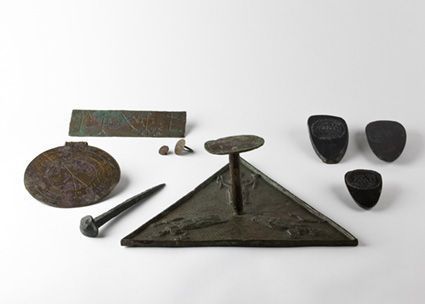 © Staatlichen Museen zu Berlin, Antikensammlung
© Staatlichen Museen zu Berlin, AntikensammlungThe triangular base of the ‘divination kit’ had a raised rim at the sides and a metal rod (h: 86 mm, d: 12 mm) set at the center, holding up a bronze disc (d: 70 mm). The angles of the triangle each represent an aspect of Hecate trimorph, wearing peplos and modius, arms bent in elbow, hands raised, their names inscribed above their heads. Phoibie (at bottom left in the image) holds a key in her right hand and a burning torch in her left hand, Dione (at top in the image) holds a whip in her right hand and a burning torch in her left hand, Nychie (at bottom right in the image) holds a serpent in her right hand and a dagger in her left hand.
The remaining surface of the triangle is covered with Greek inscription and characters.
The Pergamon Zaubergerät, first published by R. Wünsch, the triangle inscriptions read:
1 Λουλου|ζαρζαρκαθ|μαθουσμη|μυλαρθω|
Flower | zarkaras | matthous | myrrho |
5 μουσαφου||μαρχιαλα|ρισοαρηθε|ουνφωραζω|φρισσαμου|
Mashafou || marchesala | risoarithe | ounforazo | frissamou |
10 βερφορισσα||βρυχισσαφα|ρισμυθωναρ|φουνισνουναρι|φαφιλωνισφλω|
verforissa || vrychissafa | rismythonar | founisnounari | fafilonisflo |
15 χαρεοφορε[ . . ]||σιων|ενεβεν|θελησσα|βαρβωτοισ|
chareofore (Harefoot) [ . . ]|| sion | eneven | thelissa | varvotois |
20 ιωλιπαφαρ||βορβορο[φ]ορ[β]α|στριαλαλαχ|μαφυζαζαω|ναυμιλλοναθω|
Jilipaphir | sorvo [φ] or [β] α | strialalah | mafazzao | nauillinatho |
25 λαωρεοβαρβαρο||φων|ααα εεε |ηηη ιιι οοο|υυυ ωωω|
Laurencebarvar || fon | aaa eee | iii iii ooo | yyy ooo |
30 αλαλαλ ελ[-]||ιλιλιλ ολολολ|υλυλυλ ωλωλ[-]|ωλ αναναν|
Alalyl [-] - phenylethylolylsilylolyl [-]] anil |
35 ενενεν ηνην[-]||ην ινινιν ονον[-]|ον υνυνυν|ωνωνων|αραραρ|
40 ερερερ||ηρηρηρ ιριριρ ορορορ|υρυρυρ ωρωρωρ|ασασασ εσ[-]|εσεσ ησησ[-]|
45 ησ ισισισ οσ[-]||οσοσ υσυσυσ|ωσωσωσ αψ[-]|αψαψ εψεψεψ|ηψηψηψ ιψιψ[-]|
50 ιψ οψοψοψ υψυψ[-]||υψ ωψωψωψ Ἰάω|ευη Ἰάη ευοα|ζαγουρη· ευ-|ευευ· ιωιωιω·|
55 αεηιουω· αεαε[-]||αε· αηαηαη· αιαι[-]|αι· αοαοαο·αυαυαυ|αωαωαω|ωαωαωα|
60 ωεωεωε||ωηωηωη|ωιωη(!)ωι ωο[-]|ωοωο ωυωυ[-]|ωυ ωωωωωω|
65 [. .]ἰὼ||Πασικράτ[ε]ια, ἰὼ|Πασιμέδουσα, ἰὼ|πάντα ἐ[-]|φέπουσα,|
70 ἰὼ Περσεφόνη, ἰὼ Μηλι[-]||νόη, ἰὼ Λευκο[φ]ρυηνή.| Φοιβίη|Διώνη|Νυχίη|
75 Ἀμ[ε]ίβουσα.
Details:
CBd-Number: CBd-1864
ID-Number DE-Berlin-Ant_Misc. 8612,6
Collection DE_Berlin, Staatliche Museen zu Berlin, Antikensammlung
Inventory Misc. 8612,6
References Wünsch 1905, 2
Material bronze
Dimensions diameter: 128 mm; height: 10 mm
Place of discovery Pergamon, Lower Town, 1897
Dating 3rd c. AD (Wünsch)
Iconographical elements: Concentric motifs
© Staatlichen Museen zu Berlin, Antikensammlung
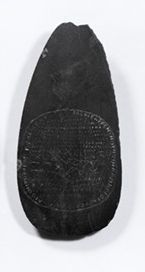 © Staatlichen Museen zu Berlin, Antikensammlung
© Staatlichen Museen zu Berlin, Antikensammlung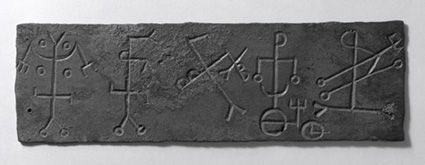 © Staatlichen Museen zu Berlin, Antikensammlung
© Staatlichen Museen zu Berlin, Antikensammlung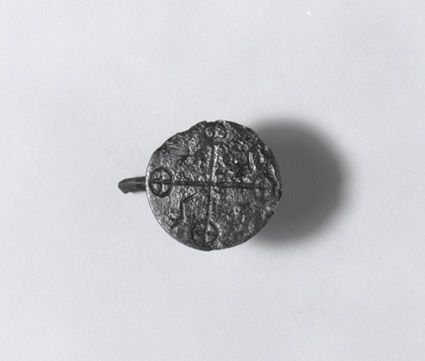 © Staatlichen Museen zu Berlin, Antikensammlung
© Staatlichen Museen zu Berlin, Antikensammlung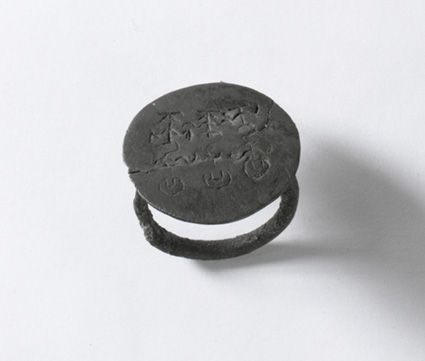 © Staatlichen Museen zu Berlin, Antikensammlung
© Staatlichen Museen zu Berlin, Antikensammlung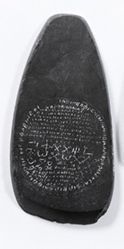 © Staatlichen Museen zu Berlin, Antikensammlung
© Staatlichen Museen zu Berlin, Antikensammlung © Staatlichen Museen zu Berlin, Antikensammlung
© Staatlichen Museen zu Berlin, AntikensammlungIn Volume 15 2002, of the Journal of Roman archaeology pp. 188-198 ‘Another view of the Pergamon divination kit’ Richard Gordon states in his abstract that the pieces are not part of a kit, but part of a ‘ragbag’ collection:
“The discovery in 1977 of a very similar ‘triangle’ in the Maison du Cerf at Apamea seemed to confirm Wünsch’s account of the kit as the equipment required to perform a type of divination very similar to that described in Hilarius’ confession relating to the seance of A.D. 371. … Wünsch’s commentary leads to a kind of revelation, the disclosure of the true sense of the kit as whole. In the last major section of his account, Wünsch discussed each object in turn, noting the use of similar objects in diverse magical contexts.
For his interpretation the crucial apparatus was the inscribed disc, which has 24 fields in the three outer circles, that is, the number of letters in the Greek alphabet. That implied an alphabet-oracle, and it was then easy to point to Ammianus’ already famous report. It is his story of the ‘wizard at work’ that caught the imagination of his readers, the story of the polished stones used as protective amulets, the ring hung from the nail over the circular disc, which was moved by the handle to create words or sentences from the signs inscribed on its surface.
If one looks closely at the disc, it is very difficult (indeed, in my view impossible) to credit that it could have served as an alphabet-oracle or anything similar. If so, does the disc belong to the triangular support at all? Can the other appliances be understood differently from the way Wünsch suggested? My argument is that we might read much of his own commentary as undercutting the final disclosure that depends so heavily on Hilarius, and that we should revert to his own initial conception of an ensemble, a group of instruments with a variety of ritual uses. Indeed, there are reasons for thinking that the individual items were not conceived as a group, but rather assembled over time from various sources as a collection. I incline to understand the ensemble as not so much a ‘kit’ as a rag-bag collection.”
Pergamon
Pergamon or Pergamum was a rich and powerful ancient Greek city in Aeolis. It is located 26 kilometres (16 mi) from the modern coastline of the Aegean Sea on a promontory on the north side of the river Caicus (modern-day Bakırçay) and northwest of the modern city of Bergama. Many remains of its impressive monuments can still be seen and especially the outstanding masterpiece of the Pergamon Altar. It became the capital of the Kingdom of Pergamon during the Hellenistic period under the Attalid dynasty in 281–133 BC.Captured by Xenophon in 399 BC and immediately recaptured by the Persians, it was severely punished in 362 BC after a revolt.
 Acropolis of Pergamon by Friedrich Thierch – 1882
Acropolis of Pergamon by Friedrich Thierch – 1882Pergamon did not become important until Lysimachus, King of Thrace, took possession in 301 BC, but soon after his lieutenant Philetaerus enlarged the town, the kingdom of Thrace collapsed and it became the capital of the new kingdom of Pergamon which Philetaerus founded in 281 BC, beginning the Attalid dynasty. In 261 BC he bequeathed his possessions to his nephew Eumenes I (263–241 BC), who increased them greatly, leaving as heir his cousin Attalus I (241–197 BC).Pergamon is cited in the Book of Revelation as one of the seven churches of Asia.
Serapis Temple
One of Pergamon’s notables structure is the great temple of the Egyptian gods Isis and/or Serapis, known today as the “Red Basilica” (or Kızıl Avlu in Turkish), about one kilometre (0.62 miles) south of the Acropolis. It consists of a main building and two round towers within an enormous temenos or sacred area. The temple towers flanking the main building had courtyards with pools used for ablutions at each end, flanked by stoas on three sides. At this temple in the year 92 Saint Antipas, the first bishop of Pergamum ordained by John the Apostle, was a victim of an early clash between Serapis worshipers and Christians. An angry mob is said to have burned Saint Antipas alive inside a Brazen Bull incense burner, which represented the bull god Apis.
In the 1st century AD, the Christian Church at Pergamon inside the main building of the Red Basilica was one of the Seven Churches to which the Book of Revelation was addressed. The forecourt is still supported by the 193-metre-wide (633-foot) Pergamon Bridge, the largest bridge substruction of antiquity.
Deciphering The Divining Disc
 Copyright Antikensammlung Berlin
Copyright Antikensammlung Berlin
The surface of the Prognosticon is divided into sectors containing different characters amongst them Greek vowels. It is comprised of 16 parts – 8 on the outside and 8 inside, each rotating in opposite directions: A circle of life the 16 separate cycles. Although the radial divisions of the three outer rings are aligned, the segmentation of the central region is not aligned with the outer rings.
The inscriptions on the convex side are arranged in 4 concentric circles and contain a large number of magical hieroglyphs, but among them are several letters of the Greek alphabet, and a whole circle of Greek vowels, the Egyptian hieroglyph for B, the symbols of the sun and moon.
The 8 outside sections are divided into 24 smaller sections= 32. So it is likely that numerology plays a large part in this pendant representing the cycles and choices in life. The concentric circles of the inscribed disc are filled with magic characters, Egyptian hieroglyphs and planetary symbols.

The systems employed remain unknown. It is believed it formed a part of the apparatus which the magicians of Pergamon used for purposes of divination and for obtaining Oracles in the first half of the third century of our Era. One theory is that the disc might have been a tool used to enter an altered state of consciousness, in which the operator would gaze at the central point of the hypnotic radial design until they entered a trance. It has been carefully described Dr. R. Wünsch in the Jahrbuch of the German Archaeological Institute, Ergänzungshaft, No. 6, 1905.
From Griechisch-Ägypischer Offenbarungszauber, Leipzig, 1924, p. 146
The picture here is of an original copy made of the original bronze one found in Asia Minor in 1899, thought to be made by the museum of Berlin during WWII by direct casting.

Cracking the Prognosticon Code
It appears that the outside ring a calender system portraying the movement of the year around the seasons, the next ring being the movement of the stars or planets in line with the seasons. The third ring shows how they relate to man with the center representing the domain of the Gods YH*V being visible next to the symbol of a man.
The system employed by the magician is unknown: Some say as an amulet it strengthens the intuition, the subconscious and, as a result, self-knowledge, imagination and creativity. It is believed by others that these types of objects with these symbols are like combination locks that connect our spiritual energies to other energy systems.
The disc is thought to be an amalgamation of magical systems and practices from the Middle East representing a much older religious/magical system of belief, older even than most modern archaeologists suspect. Some common symbols used on the King Solomon amulets are visible.

What do the symbols represent? The mysteries of the symbols share a lot of common ground with:
Hemisphærum Avstrale Coelestium
Is the title of a plate by German Jesuit priest Athanasius Kircher (1601-1680) of a graphic representation of the heavens made in his work Oboliscus Aegyptiacus. Kircher was the brightest scientific star of his day. Towards the end of his life, though he was to be eclipsed by the rationalism of René Descartes and others he is still “a giant among seventeenth-century scholars… one of the last thinkers who could rightfully claim all knowledge as his domain”.
Kircher’s ‘Alpahetvm Scriptvræ Coelestis’ shows the night heavens called by Kircher ‘Hemisphæreum Coelestium’ – deciphering the mystery of mysterious symbols that have long plagued archaeologists and students of esoterica. What the stars or constellations on the Prognosticon are, remain of course still open to interpretation, but there can be no doubt, that with reference to Kircher and Kircher’s interpretation of ancient studies that the peculiar symbols decode the heaven into some form of symbolic script.

The nature of the mystery can therefore be partly answered with reference to Kircher’s work, revealing the use of symbols to group stars in a codification of the heavens. If the symbols represent stars as a script, this resolves the mysterious symbols. With reference to Kircher’s work, it is possible that the Prognosticon reveals stars or constellations as a script to be read, but what they are remains open to interpretation. Could the disc be a means of decoding the heavens as a symbolic script?
Kircher
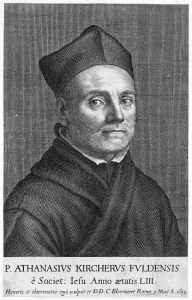 Described as the last man of the Renassiance, Kircher was “a champion of wonder, a man of awe-inspiring erudition and inventiveness,” whose work was read “by the smartest minds of the time.” He is known in history primarily as the man who drew the map of the fabled Atlantis.
Described as the last man of the Renassiance, Kircher was “a champion of wonder, a man of awe-inspiring erudition and inventiveness,” whose work was read “by the smartest minds of the time.” He is known in history primarily as the man who drew the map of the fabled Atlantis.Kircher cited as his sources Chaldean astrology, Hebrew kabbalah, Greek myth,Pythagorean mathematics, Arabian alchemy and Latin philology. Modern experts on hieroglyphic writing have found Kircher’s work to be of little value. Another symbol featured in Kircher’s writings is the seven-pointed star.

Kircher argued that Coptic preserved the last development of ancient Egyptian. For this Kircher has been considered the true “founder of Egyptology”, because his work was conducted “before the discovery of the Rosetta Stone rendered Egyptian hieroglyphics comprehensible to scholars”. He also recognized the relationship between hieratic and hieroglyphic scripts.
In Oedipus Aegyptiacus, Kircher argued under the impression of the Hieroglyphica that ancient Egyptian was the language spoken by Adam and Eve, that Hermes Trismegistuswas Moses, and that hieroglyphs were occult symbols which “cannot be translated by words, but expressed only by marks, characters and figures.” This led him to translate simple hieroglyphic texts now known to read as dd Wsr (“Osiris says”) as “The treachery of Typhon ends at the throne of Isis; the moisture of nature is guarded by the vigilance of Anubis”.

Egyptian-Coptic Links
Scholars of the 20th century discovered amongst Kircher’s writings, correspondence with hieroglyphic inscriptions deciphered to represent past events thought unique – Kircher illustrating sources lost to science. He established the link between the ancient Egyptian and the modern Coptic languages, and some commentators regard him as the founder of Egyptology, while others that his writings were too subjective to have been science.
The Prognosticon is the source of ongoing research.
Links
http://www2.szepmuveszeti.hu/talisman...
http://emp-web-24.zetcom.ch/eMuseumPl...
http://emp-web-24.zetcom.ch/eMuseumPl...
May 18, 2017
The Elven Star Eärendil and The Norse
Sources for the shining light of the Silmaril that had been rescued from the the Northern Lands of Angband by the elvish-man couple Lúthien and Beren.
You can sign up for the occasional Elements newsletter , follow Mark David on Twitter @authorMarkDavid . You can read more about his fiction on medium .
Following the background section explaining why I am developing a new kind of book bridging fact with fiction is an extract from the forthcoming series Viking Legends & Norse Mythology Source Book. Among those visitations to be undertaken in the series, are Nordic connections to Tolkien, beginning the untold story of some of the many influences from Nordic myths and legends that helped shape the development of Middle Earth.
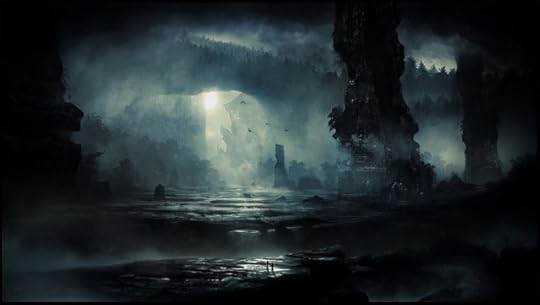
Niflhel —copyright by Dominique Velsen on Deviant Art
Background
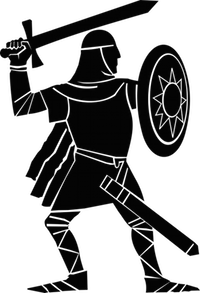
The book itself is really a personal voyage of discovery, a journey embarked on since 2007 when I started writing the fiction project The Elements.
The forthcoming publication arises from much of the source material gathered over the years, part of my quest to write ‘The Lord Of The Rings in the real world’, to envisage and realise a hard-boiled but epic series as big as anything from fantasy including the likes of Game Of Thrones.
Wanting to have something set in the real world, yet with the sort of depth we love from the greats, I turned to a world of legend and myth that has been probably the greatest source of inspiration for most fantasy out there — Nordic Mythology. From humble beginnings, the research, the places and discovery of Nordic legends has fueled and continues to fuel an imagination that perhaps, more than anything else has been hell-bent on recreating the past. This book is the revealing of Nordic sources and the tales I have come across in the telling of tales.
One of the lessons I have learned on this journey is that myths are more a way of life, than just a way of seeing or believing the past or how the present came into being. Creating fiction based on true-to-life crime and mystery is far removed from the liberties available when creating a work of fantasy. I wanted it to live and breath, and yet I needed it to remain a backdrop that engaged the imagination of the reader.
The Quest for a Different Kind Of Story

To understand the land and the people known as the Vikings, I’ve spent long periods of time living in especially Sweden and Denmark, building a large network of people, people I am indebted to in the writing of this book. This book is a re-examination of Nordic Mythology, providing first-hand accounts, insights into legends, the deeds of heroes and anti-heroes, all the acts of courage and belief.
Just getting the first book out in the series has been both a journey — and a quest. As a quest, summer holidays for the most part, I’ve travelled far and wide researching the background for the story, taking in many different aspects of Scandinavia, have visited National Museums, travelled into the outlying national parks of Sweden, visited crystal clear lakes swimming in the light of the setting sum, admired the waterlillies on the lakes with water the color of ink, have walked many of Sweden’s national parks in the sun, wind and rain, all of which add a surprising understanding of place. These places in turn provided me with the detailed insight into the history of location, one little discovery added to the next, combining as a ‘sum of discovery’ — making places of the imagination real and believable as if they were our own.
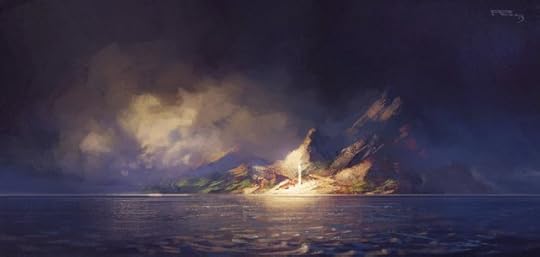
Haven of the Eldar. By Frédéric Bennett on Deviant Art
Extract: Tolkien Connections

Revered by the Elves, it was the light of the star Eärendil that was said to lead the men of the isle of Númenor, the Númenorians to Middle Earth in the Second Age. Eärendil was also a mariner. One of the half-elven Peredhil who was a descendent of the original men of the elder days, he sailed his elegant boat Vingilot wearing the Silmaril on his forehead.
The star of high hope, Gil-Estel, shone with the light of the silmaril brightly in the Western sky, a light so brilliant it his the light of the all the other stars in the night sky, creating the Numeórean name for their new land, Elenna, meaning ‘starwards’ — or the fuller Elenna·nórë meaning ‘starwards land,’ the light of the star was the incarnation of Eärendil himself, following the great war of wrath, resulting in the destruction of a swathe of Western Middle Earth called Beleriand. The light of Eärendil is also something we are well familiar from Peter Jackson’s filmatization, featured in the small glass vial given to Frodo by the lady Galadriel, to be used to shine light in dark places when facing the perils on the road to Mordor.
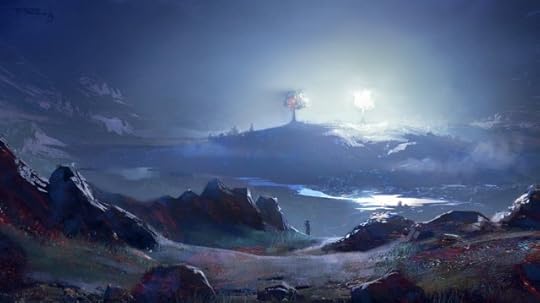
Telerion Goes To Sleep, Laurelin Awakes. By Frédéric Bennett on Deviant Art

A star, a name, a great war, a guiding light, all have remarkable similarities to Nordic legends concerning the name Auzawandils/ Auzawandila, a Gothic equivalent of the name Aurvandill. Called Earendel by the Saxons, Auriwandalo by the Lombards and Aurvandil by the Norse, Aurvandil/ Earendel are obvious sources for Tolkien’s Eärendil. Aurvandil the man had his frozen toe thrown into the sky by Thor — in turn to become a bright star, possibly Venus. The Quenya phrase “Aiya Eärendil, elenion ancalima!” translates as “Hail Eärendil, brightest of stars!”, almost identical to the line “Hail Earendel, brightest of angels” in Crist I, going even so far as to use the same syntax as the Old English version. In the Old English poem Crist I follow in lines 104–111:
éala éarendel engla beorhtast
ofer middangeard monnum sended
and sodfasta sunnan leoma,
tohrt ofer tunglas þu tida gehvane
of sylfum þe symle inlihtes.
Swa þu, god of gode gearo acenned,
sunu soþan fæder swegles in wuldre
This translates as:
‘Hail Day-Star! Brightest angel sent to man throughout the earth, and Thou steadfast splendour of the sun, bright above stars! Ever Thou dost illumine with Thy light the time of every season. As Thou, begotten God of God, Son of the True Father, without beginning.’

Earendel has also been called ‘the brightest of angels’. Eärendil the Mariner finds correspondence in Orendel the mariner, possibly originating as a Vandal sea-king, becoming the Danish Orvendill the father of Amleth we know from Hamlet!
Others have related Auza-wandilaz, with the first element from the Indo-European root aus– for ‘dawn’, suggesting ‘dawn-wanderer’ or ‘dawn-turner’, a fitting name for a morning star. In Manichaeism, Auzawandilaz is a deity depicted as a cloaked man with a sword in one hand and a lantern in the other, known as ‘the Luminous Wanderer’, a god similarly associated with the light of dawn and/or the morning star, said to be waging eternal war against the forces of darkness, Muþspel or Muspell, the Nordic envisioning of ‘the end of times’, the end of which we know better called Ragnarok.
In Ragnarok is the great final battle between Gods and giants that leads to the destruction of the world. According to the Germanic Muspell, Auzawandilaz will then sacrifice himself to preserve two members of the human race, so that humanity may be reborn.
Interestingly, the priests of Auzawandilaz are described as ‘a very secretive organization’, who often gather at dawn to worship the morning star and the rising Sun.
May 10, 2017
Draugar
The Draugar, the living undead we know from Tolkien, not zombies were known as the Draugar.
The following is an extract from chapter 2 of Volume 1 of Viking Legends and Norse Mythology, The Underworld and the Afterlife.
***
image credit: Draugr Wight from Elder Scrolls. Fandom wikia licensed under the Creative Commons Attribution-Share Alike License 3.0 (CC-BY-SA).
***
“He struck the head off the draug, and burned him up in the fire, then went out of the barrow. Then the men asked how Thrain and he had parted. He said that he went in choice, “then I struck off his head.”
– Hrómund Saga Gripssonar
Tolkien borrowed this concept from Norse mythology, being most closely related to the legend of the Draugr, introducing aspects of the Draugr legends introduced in the saga of Hromund Gripsson. So just as Tolkien’s Barrow Wights are the undead spirits inhabiting the mounds in the bleak, misty landscape of the Barrow Downs, such beliefs were a part of the Nordic mythological landscape, featuring places that have a lot in common with the moors of England and Wales just as well as Scandinavia.
Tolkien’s Barrow Wights were directly invented from the Scandinavian draugr or draug. The Old Norse is draugr, with links to the Gothic word driugan, for ‘prolonged fight’. One drauger, two draugen or draugur, also called aptrgangr, literally ‘again-walker’ is an undead creature from Norse mythology, a subset of Germanic mythology. This is similar to, yet different from the Haugbui, (Haug comes from haugr – meaning ‘howe’) barrow-dwellers who would defend their barrow territory without leaving it.
The Living Undead
The Draugr is the Norse name for the undead. Once a body was placed in a grave, it didn’t just stay there and decay to dust. It became possessed, taken over by the wandering spirit of the ground. Animated with power and life. An undead corpse. Draugar live in their graves, often guarding treasure buried with them in their burial mound. They are animated corpses – unlike ghosts they have a corporeal body with similar physical abilities as in life. Older literature makes clear distinctions between sea-draugar and land-draugar.
“After six days had passed, they came to an opening in the barrow. They saw a great ugly man sitting in a chair, blue-skinned and stout, all clad in gold, so that it glittered. He chattered much and blew on the fire.”
– Hrómund Saga Gripssonar
The legend of the Draugr is a product of the vivid imagination of a hardy folk working hard to survive the cold and dark of a Scandinavian winter. It is easy to understand how such legends were born, the draugr would leaving their barrows, attacking the settlements. The draugr’s victims were not limited to trespassers in its howe. The roaming ghosts decimated livestock by running the animals to death while either riding them or pursuing them in some hideous, half-flayed form. Shepherds, whose duties to their flocks left them out of doors at night time, were also particular targets for the hunger and hatred of the undead:
“The oxen which had been used to haul Thorolf ’s body were ridden to death by demons, and every single beast that came near his grave went raving mad and howled itself to death. The shepherd at Hvamm often came racing home with Thorolf after him. One day that Fall neither sheep nor shepherd came back to the farm.”
– Palsson and Edwards, Eyrbyggja Saga
Draugr the living undead of spirits who take the form of dead warriors are becoming an increasing area of interest for gamers, game designers and the creation of draugr fantasy↵ (link to the Elder Scrolls).
Generally, it was believed that any person who exhibited mean, selfish or nasty traits could be susceptible for being turned into a draug. In particular selfishness was one sure way to – not end in Hell – but become the corpus for eternal unrest, forced to stay in a world where the only way to exist was to prey upon the flesh of the living.
After a person’s death, the main indication that the person will become a draugr is that the corpse is not in a horizontal position. In most cases, the corpse is found in an upright or sitting position, and this is an indication that the dead might return.
Unlike ghosts, draugar can also come about through infection by another draugr such as in the story of Glámr. When Glámr arrives in the haunted valley in Grettis saga, “the previous evil spirits are relegated to the sidelines and, when Glámr is found dead, they disappear, whereas he takes over their role as ghost of the valley.” Although Glámr is a marginal character to begin with, it is only after his fight with the first malignant spirit that the first spirit leaves the valley, and Glámr takes its place wreaking havoc. Similarly, in the Eyrbyggja sagaᚠ, a shepherd is killed by a draugr and rises the next night as one himself.
April 17, 2017
Revisiting Nordic Mythology
This is just one of the questions I’ll be looking at in this series, since I decided this Easter to do something about an idea I’ve had for a long time, to write a completely new take on Norse Mythology, using all of the knowledge accumulated over a decade and bring it out into the light of day.
What are the meaning of runes?
Background
 Perhaps it is the reading of such tales as the Lord Of The Rings (LOTR) that has sparked a fascination for wandering the lands of Scandinavia, looking for those remote locations where burial mounds and rune-stones dot the landscape. In the days when my two sons were young, often would be heard groans of complaint about having to drive to yet another remote place, just so Dad could take another handful of photos to add to his collection. How could anyone explain to the young the fascination in rediscovering a past we can only read about in the sagas?
Perhaps it is the reading of such tales as the Lord Of The Rings (LOTR) that has sparked a fascination for wandering the lands of Scandinavia, looking for those remote locations where burial mounds and rune-stones dot the landscape. In the days when my two sons were young, often would be heard groans of complaint about having to drive to yet another remote place, just so Dad could take another handful of photos to add to his collection. How could anyone explain to the young the fascination in rediscovering a past we can only read about in the sagas?
As Tolkien, in addition to visiting, I’ve read, studied, immersed, absorbed, created, visited, photographed and imagined anything to do with the Norse culture of old to weave them into the present. From the Icelandic Sagas, to visiting places in Denmark, Sweden and Norway, this book is the result of all those years spent doing these many many things. I’ve also studied the languages – to the best of my ability – I write, read and speak Scandinavian languages, accessing many sources not available in the English language.
I have deliberately not re-served the myths we can pluck from wikipedia, but have been selective, touching on some unusual places and aspects that can’t normally be found in the interests of creating a completely new way at looking at the Norse and Nordic Mythology.
See the Viking Legends and Norse Mythology homepage
 AIMS:
AIMS: My aims are simple: Just like my fiction projects, I want to leave the reader with is the same feeling of seeing something familiar from a whole new perspective, that almost like a new universe, is so close to our own and yet being fiction, being uniquely esoteric.
The book follows on from all the work undertaken writing The Elements, what I’ve called ‘The Lord Of The Rings in the real world’. As LOTR was one big work of evolution based on years of research into the lost myths of old Europe, similarly, in the writing of The Elements I undertook many years of journeying far and wide driven by the idea of writing something similar in scope, capturing the allure of en epic, but embedded within the terra firma, not of Middle Earth, but of our own, rediscovering a lost Nordic past and bringing it up into the light of world as real, living and breathing as our own in fiction and now as a book of the field of study itself.
With all the work done, and so many threads in Nordic sagas discovered, it’s now time to bring these all out into the light of day.
I will be revealing new legends, beliefs about the afterlife, gods, legends and locations, bringing them alive with reference to a number of key selected texts to accompany my detective work. I’ll also be relating these to Tolkien and the work of pioneers like Thor Heyerdahl in uncovering the illusive truth concerning the Norse, the Nordic gods, and from whence the legends originated.
Signup to receive pre-release news and where extracts of the book can be read in advance of publication.
All new sign-ups receive a link to the first 10 chapters of The Prologue to The Elements, Fear Of Broken Glass featuring much of the research into macabre Nordic-pagan rituals.
January 13, 2017
Elements Introspection Part 6
To receive news about the series and releases, sign up for The Elements newsletter. Read more about the release of The Elements Prologue.
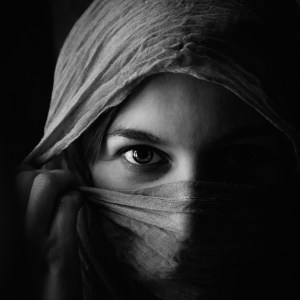 Most books are constructed around presenting the reader with a lead character to identify with emotionally and intellectually through thick and thin. However, while suitable for a single book, this is limiting for a series with focus on relations and multiple points of view such as we know from fantasy (TLOTR, Song Of Ice and Fire) Science Fiction (Dune series), Conspiracy Thriller (X-Files), Thriller (Ludlam’s Bourne trilogy, Larsson’s Millennium trilogy), that each in their own way introduces different sub-plots as semi-independent stories, adding layers of complexity, the series gaining momentum by how it is navigated as the threads are submersed within then navigated, following each and the developing connections as the sub-plots evolve.
Most books are constructed around presenting the reader with a lead character to identify with emotionally and intellectually through thick and thin. However, while suitable for a single book, this is limiting for a series with focus on relations and multiple points of view such as we know from fantasy (TLOTR, Song Of Ice and Fire) Science Fiction (Dune series), Conspiracy Thriller (X-Files), Thriller (Ludlam’s Bourne trilogy, Larsson’s Millennium trilogy), that each in their own way introduces different sub-plots as semi-independent stories, adding layers of complexity, the series gaining momentum by how it is navigated as the threads are submersed within then navigated, following each and the developing connections as the sub-plots evolve.
Each book will produce the reasons for what happened in the previous book, as a book-to-book process of discovery, back-projected into each chronologica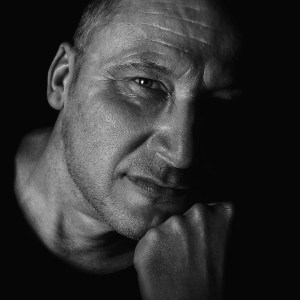 l piece in a very large and very complex puzzle… During the course of the story, the reader puts the pieces of the story mosaic together as a search for truth. As the elements are combined, the true nature of the back story is revealed, revealing a bridge spanning two previously separate worlds – the true historical-archaeological world of revelation and the false world of deception. The bridge itself and the key to unlocking that bridge is only revealed at the end of the series resolving all story threads across all the timelines, revealing through their combination the back story and historical relevance with a subtle paranormal twist.
l piece in a very large and very complex puzzle… During the course of the story, the reader puts the pieces of the story mosaic together as a search for truth. As the elements are combined, the true nature of the back story is revealed, revealing a bridge spanning two previously separate worlds – the true historical-archaeological world of revelation and the false world of deception. The bridge itself and the key to unlocking that bridge is only revealed at the end of the series resolving all story threads across all the timelines, revealing through their combination the back story and historical relevance with a subtle paranormal twist.
As a journey through place and time the series covers scenes based in London, Copenhagen, Rome, Berlin, Denmark, the Baltic region, the hinterland of Sweden, Istanbul, Switzerland and Eastern block Rumania, and is far removed from the worlds of John Le Carré or Ian Flemming. So while The Elements series transcends the deeds, mysteries and conflicts of the most devastating century in the history of man kind, it does so by working with different sub-plots and timelines linking real and fictitious events. The result is a multi-layered universe submerging the reader into a complex world of intrigue and discovery at a time near to the end of the cold war.
kind, it does so by working with different sub-plots and timelines linking real and fictitious events. The result is a multi-layered universe submerging the reader into a complex world of intrigue and discovery at a time near to the end of the cold war.
The result will, I hope, be a series where the stories and timelines possess the depth and breadth of vision of epic fantasy, but populated by archaeological discovery, Nordic mythology, the fight for freedom and the past deeds of forgotten heroes to add a thematic vitality to make it unique.
You can also follow Mark David on twitter.
January 11, 2017
Elements Introspection Part 5
To receive news about the series and releases, sign up for The Elements newsletter. Read more about the release of The Elements Prologue.
Why set an epic at the time of the Cold War?
I always wanted to write best fiction story I could: Real, gritty, expansive and ever more complex, like a great tree – but with roots going deep into dark places. I wanted it to be big, bold and something completely different than what was on offer, breaking the boundaries across different genres. I had never conceived this kind of story would be set during the cold war. It was simply never my intention to do so. Then, as the story developed, the need to review events farther back in time meant relating story to the memory of those involved in momentous events – being both the first and second world wars, the ideology that lead nations into conflict on an unprecedented scale. The cutting off point for that memory to function in a story involving conflict in the present is the mid to late eighties. Then it was possible to have a young man of 21 in 1917 still be around to tell the tale of what he discovered at the end of his life in 1987, before being too old to recall…

So was born the story background where Europe is moving towards a final confrontation, except, none of the ruling elite can now see it coming. The world, also today, has changed. No longer are enemies known – or seen. They become a part of the shadow-world, a dark backdrop where people just disappear for no reason. In this world, the fall of the Berlin Wall is not anticipated, the powers behind the scenes busy building evermore intricate webs of deception. There are also invisible forces working behind the scenes in a race to maintain a balance of power. Except, none of the lethal and manipulative game of puppet masters is understood by the agents out in the cold, caught within an intricate web of intrigue and deception. Caught in the game, to find the way out, they have to discover the past the powers will go to any length to keep hidden.
This kind of dark, almost dystopian backdrop is the feel I wanted for the elements – a tale of stepping forward on a twisting road leading to the truth, picking up discoveries along the trail. I also wanted a younger cast, those who were born years after such great events, step forth on the journey. With youthful vitality and often humor, they question what it is all about, so the journey itself becomes irrelevant to them, compared to the importance of the discoveries made and those people who make it all worth while. The story thus becomes like a puzzle. Not all the young are the innocent, and it becomes clear that there are those who, despite being born into another age, are capable of deeds of violence to equal of those of the previous generation, but caught within a cynical world that simply doesn’t give a damn who they are. Thus were the various story-pieces in the game of deceptions formed.

Turning the puzzle into a code
I love making puzzles, I love visualizing them and I love teasing the mind with greater perspectives: So finally, I have arrived at the sort of project I would love to buy but can’t find. (I did say The Elements was going to be something quite unique.) It has surprised me though, just how useful it has been to take a step beyond any book and look at the entire project. The ‘coding exercise’ as such, has been to come up with simply identifiable motifs that visually provide a quick reference to The Element.
What I hadn’t expected was that the concept for the whole project would take ALSO take a big step forwards, snapping the whole into sharper focus:
For the first time since starting I can see everything now and how it all fits together. The process of grow and divide by organic development has meant that The Elements will now also play a direct role in terms of plot. Each element is a code name, for the powers that be, doing what they do, in line with their objectives. Which is all core back plot material. So each element, while being a thematic filter on the nature of the story, also relates to a particular deception being made by the puppet-masters.

The deception aspect had been written into the stories, it’s only now I can see that each book can illustrate its own deception, so The Elements as a whole have three levels of meaning:
– Thematically (thematic play)
– Figuratively (meaning)
– Strategically (plot and structure)
January 8, 2017
Elements Introspection Part 4
The Elements introduces a multi-layered story universe submerging the reader into a rich and complex world of discovery at a time near to the end of the cold war. The front story is set 1986-1988, following the pre-sequence of events in the wake of a macabre discovery of a murder victim in the Tiveden National Park in Sweden in Beyond The Light Of Reason. The Elements draws on a vast pantheon of characters, covering a timespan of over six decades – from the years immediately before the fall of the Berlin wall back past the hidden deeds of the second world war and farther back in time. Working with four timelines, each book examines a different element in a growing perception of reality.

The Elements has developed semi-independent storylines, but, and here was the real challenge, all linked through a plot that weaves people, incidents and outcomes together across prolonged periods of time, almost as real as life and our understanding of it viewed across a rich historical backdrop. It was felt from the start that some big ideas needed capturing to what it was all about and provide significant depth in concept as well as breadth.
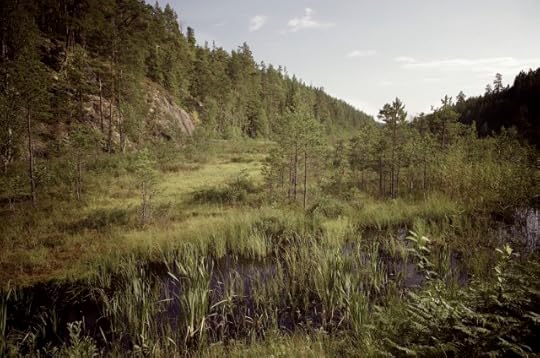 Tiveden: The national park featured in The Prologue
Tiveden: The national park featured in The PrologueTo this extent the story development has been developed organically over a number of years, guided by the central underlying premise that ‘reality’ is not absolute but determined by those who have gone before us. The Elements develops premise through the quest for truth using the three universal themes: time, belief and fate. These are represented by the story elements archaeological discovery, esoteric doctrine and the Nordic understanding of ‘wyrd’ – our actions determining our present are conditioned by those before us, as we ourselves define the conditions for others in the future. The three themes together link different people at different times through circumstance (time), idea (belief) and action (fate) – conditioning the development of the sub-stories into a whole with universal undertones.
Everything has an origin…
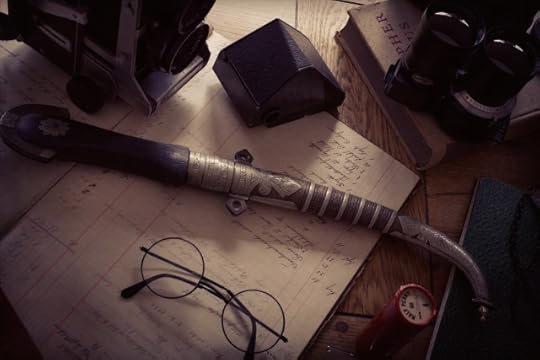
The reader enters a hidden universe in a constant state of mystery, unsure of who the people are and what side of the moral line the characters ultimately lie on. The intention has been to blur the lines, creating a gripping and intense journey into a dangerous world that can only be glimpsed beneath the surface – relating it to discoveries that normally wouldn’t belong at all in a conspiracy or espionage thriller. The use of the elements as a thematic concept becomes more literal as the series unfolds. The characters navigate through their respective worlds of chaos and confusion, deception and revelation, piecing the story elements together figuratively and literally. Perception and understanding of the whole emerge as elements are combined, with ongoing and mounting implications.

The Elements series also breaks most rules of writing. Being a conspiracy mystery thriller it teases by withholding the juiciest morsels while serving others in a true-to-life work of fiction. This becomes more apparent as the series unwinds – a creative adventure, a rolling journey of discovery asking questions, some answered, new questions emerging, weaving in aspects of myth, legend and not least some disturbing facts about the 20th century few people knew existed. Conveying the sheer depth and storylines of a series, it is not enough to merely provide a few chapters and synopsis of the books written (or those being planned). If the story being developed is going to be given any justice, it is important to appreciate not only what it is and what it is about, but also the artistic intentions constructing it. And perhaps more importantly, an appreciation of how all the different elements are related together.
To construct a tale that is as wide as it is deep, the series progresses along two parallel timelines. The present time frame of the eighties one in Europe, the other journeying farther afield to North Africa and the Middle East in the period from 1917 with investigations relating to archaeological expeditions to the 19th century with focus on Scandinavia encompassing Europe and the Middle East in the years 1917-1989.
January 3, 2017
T-12: Prologue Front Matter

On opening the Kindle file, the first thing the reader till read, is this:
Introduction to The Elements Project
7 elements. 7 deceptions. 7 revelations: The Elements is a very big undertaking and quite unique. There is no other project quite like The Elements, the result of many years of dedicated research and development.
This first book – the Prologue – is the story I began ten years ago. I started researching in 2006, wanting to combine the esoteric feel of The Da Vinci Code with the gritty realism of Scandinavian Noir (or ‘Nordic Noir’) we know from books such as Stieg Larsson’s Millennium trilogy and The Girl With The Dragon Tattoo. Add to that interest in ‘the strands of people’s fates through time’, a dose of Nordic mythology wrapped inside a secret code, a conspiracy aspect only gradually revealed not unlike the X-files – and The Elements as a series was born.
I started writing in 2007, expanding the story to encompass many different threads, characters and timelines, all bound together by discovery and not a little intrigue. The result is a series starting from humble beginnings, growing into a multi-layered epic.
This prologue is that humble beginning. Based on my own love affair with Scandinavia and the legends that have formed that corner of the world, the story unwinds, starting with a crime, opening into a labyrinthine mystery tour that’s often kept me up late at night constructing it. So in the infamous words of J.R.R. Tolkien, ‘the tale grew in the telling’ – now encompassing at least twelve books being planned for publication and serialization 2017-2022.
Your help is needed to spread the word
This independently published project is not actively marketed – other than by online platform and by social media. If you enjoyed the story and the universe it is a part, please tell others about it. The Elements aims to be adapted by screenplay for televising and can only realize potential by word of mouth – recommendations by readers, to people you know.
If you are able to support the project by telling others, or by writing online posts, reviews or articles, please share your thoughts to help bring The Elements to a wider audience. Feel free to drop me a line if you have any ideas how you could help – or if you have thoughts about how the story can be improved. As we say, ‘the proof of the pudding is only in the eating’, and a recipe once created is there to be improved on.
Want to review this book on Amazon?
Go to the Amazon product page for Fear Of Broken Glass (hyperlink to page).
Click Write a customer review in the Customer Reviews section.
Click Submit.
Newsletter
Sign-up for The Elements newsletter and be informed of new releases and back-story information (or go to the sign-up button on the sidebar on Elements homepage on Elementamundi.com).
Elementa Mundi – The Elements Universe
To provide more insight into The Elements universe the Elementamundi.com site will feature:
Gateways to different products, including serializations expanding the storylines, timeline books portraying the discoveries in the past affecting the protagonists in the ‘present’ near the end of the Cold War and illustrated multi-media books.
A character lexicon featuring who they are, what they look like, their character arcs.
Timelines illustrating the deeds of the past that have combined to influence the present.
Locations with extensive photographic resource being developed to illustrate the vast and expanding Elements backstory.
Enquiries to the author
Enquiries can be addressed by email to: authormarkdavid@gmail.com
After ten long and lonely years, let the story finally commence…
December 22, 2016
Elements Introspection Part 3
The Elements is an exploration of time, belief and fate. This is based on archaeological discovery and esoteric doctrine is the common thread linking different people at different times together, linked by chance, circumstance, ideas and actions. The central underlying premise that ‘reality’ as ‘actions-in-time’ is multi-threaded and determined by those who have gone before us, our actions partly determining our present as we ourselves define the conditions for the future.
Theme
Each book has a distinct thematic identity working with the classical elements air-earth-fire-water, expanded to the elements stone, mist and ice reaching the esoteric number 7 forming the basis for 7 deceptions and 7 revelations revealed throughout the working of the series.
Each theme therefore, is interpreted figuratively and literally, each element book becoming an exploration of an emerging whole where perception and understanding comes together. The use of the elements as a thematic concept becomes more literal as the series unfolds, the real meaning of the elements becoming apparent at the end and how they are combined, answering the questions raised in the prologue.
Structure
Each book takes the reader on a voyage of the imagination going deeper into the secrets of the past as the West and East move closer towards conflict. Heroes, anti-heroes, legends of the past, the fading resistance generation, power brokers, puppet masters, spies, controllers and gatekeepers are just some of the people and events covered in the series.
Based on real places, real events, real people, history married to fiction in a contemporary post-modern idiom, The Elements is a new concept for entertaining literary fiction: It works with a compelling and intricately detailed plot, drawing extensively on the wars and wartime and archaeological secrets of twentieth century.
As the threads come together, the complete story is woven into a search for the truth – revealed to be far more meaningful than the those conditioned by the schemes of the intelligence community. Some of the subjects covered to this end include mythological aspects (draugr killings in the Prologue, the saga of Rómund, Æsahult church, numerous Egyptian references in The Labyrinth trilogy that will develop throughout the series), unknown aspects of the transition from WWII to the cold war (illegal liquidations of the Nightingales resistance group; the attack on the Shell House, secret underground operations), past key discoveries covered up because of conflicting interests.
The resulting Elements concept unites the books by a thematic code. This is used to order the story elements as an interpretation of the elements: Darkness, Earth, Stone, Water, Air, Ice and Fire.



